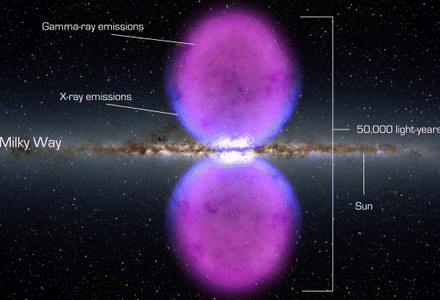CfA astronomer Doug Finkbeiner, together with two of his students, Meng Su and Tracy Slatyer, used NASA's Fermi Gamma Ray Telescope to study the diffuse gamma ray emission. They revealed humongous bubbles of high energy emission protruding about 50,000 light-years above and below the galaxy, and centered on its nucleus. Recently, it was confirmed independently from IBEX observations, the Sun going to enter soon a million-degree galactic cloud of interstellar gas.
At the time of this prediction, astronomers believed that the cores of galaxies, including our own, become active ("explode") about every 10 to 100 million years and stay active for about a million years. Since our own Galactic core presently appears quiescent, they believed it would likely remain inactive for many tens of millions of years. Although in 1977, astronomer Jan Oort cited evidence that our Galactic core has been active within the past 10,000 years. In Ph.D. dissertation, Paul LaViolette hypothesized that galactic core explosions recur about every 10,000 years and last for several hundred to a few thousand years. He was the first to suggest such a short recurrence time for galactic core explosions and that our own Galactic core undergoes Seyfert-like explosions with similar frequency. In 1983 Paul LaViolette presented evidence to the scientific community indicating that galactic core explosions actually occur about every 13,000 - 26,000 years for major outbursts and more frequently for lesser events. The emitted cosmic rays escape from the core virtually unimpeded. As they travel radially outward through the Galaxy, they form a spherical shell that advances at a velocity approaching the speed of light.
LaViolette's research suggests that the Sun also became highly active as dust and gas falling onto its surface induced extreme flaring activity. Together with the radiation influx from the Sun's dust cocoon, this caused the Sun's corona and photosphere to inflate, much as is observed today in dust-choked stars called "T Tauri stars." These various solar effects caused atmospheric warming and inversion conditions that facilitated glacial growth which brought on ice age conditions. On occasions when the solar radiation influx to the Earth became particularly high, the ice age climate warmed, initiating episodes of rapid glacial melting and continental flooding. There is evidence that one particularly tragic solar flare event occurred around 12,900 years ago during a period when the Sun was particularly active. This involved the release of an immense coronal mass ejection which engulfed the Earth and induced a mass animal extinction. Details of this scenario are described in Paul LaViolette's book Earth Under Fire as well as in a series of journal articles he has published. Astronomical observations show the last major Galactic core explosion occurred as recently as 10,000 to 15,000 years ago.
LaViolette has an analysis of this evidence of a superwave event on his blog (YT video). The geometry of the bubbles coincide with a superwave event occuring approximately 26000 years ago, which is supported by evidence in the ice core record. Data obtained from polar ice core samples show evidence of this cosmic ray event as well as other cosmic ray intensity peaks from earlier times.


